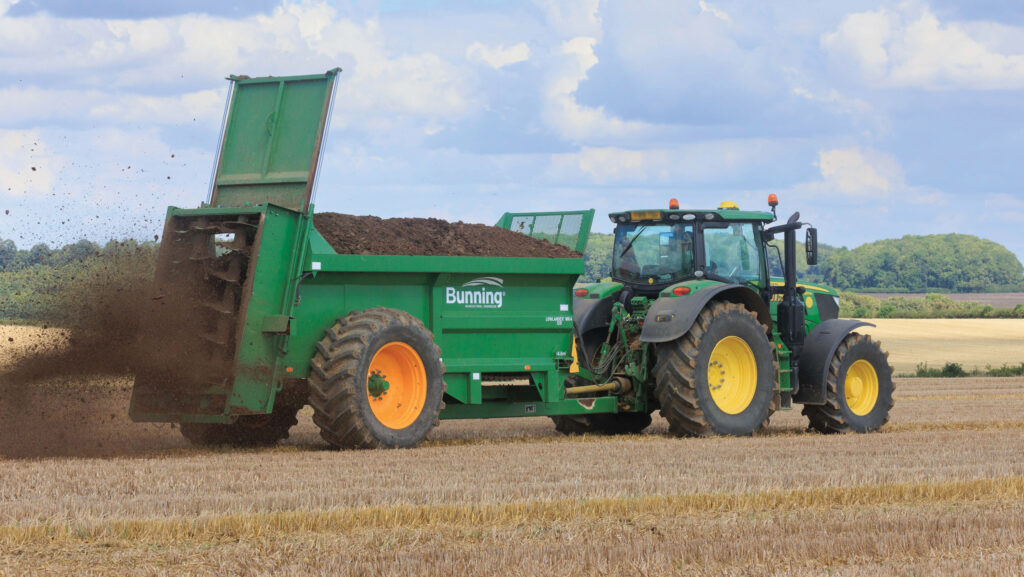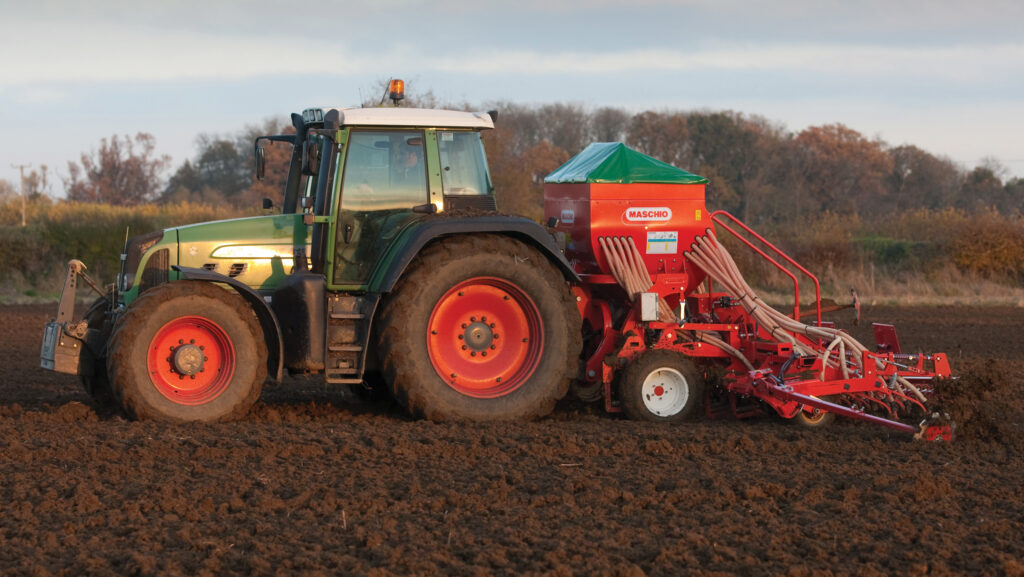Advice on future-proofing arable farms as margins tighten
 Organic manures can build soil health and cut artificial fertiliser costs © Tim Scrivener
Organic manures can build soil health and cut artificial fertiliser costs © Tim Scrivener Arable farmers are under increasing pressure to deliver more with less. At a time when grain prices are at rock bottom, what can growers and the wider industry do to keep farm businesses afloat?
At a recent Farmers Weekly roundtable discussion, partnered with seed company KWS, crop breeding, tailored agronomy and integrated livestock systems came up as some of the solutions to these turbulent times.
A range of industry experts sat down to discuss the future of crop production, and what steps can be taken to ensure the industry stays one step ahead.
See also: How herbal leys can benefit the whole system
More with less
As UK agriculture shifts towards cost-focused and regenerative systems, a growing question is being asked: How are cropping practices keeping up with the changes?
Cambridgeshire farmer James Wombwell said: “Farmers are trying to generate as much output using as minimal inputs as possible. This is becoming more-and-more apparent as margins get tighter.”
Traditionally, crop breeding revolved almost solely around yield potential.
However, KWS head of product management Kate Cobbold explains how today’s approach focuses on a range of agronomic traits such as disease resistance and nutrient use efficiency.
“It’s not just about yield anymore. Breeders are broadening their genetic pool and investing significant resources into new breeding technology,” she says.
“From a KWS perspective, this is evidenced by the fact almost 20% of company revenue goes back into research and development,” says Kate.
“We employ about 1,900 people in breeding and technical development and estimate yield improvement down to genetics in the region of 1-2% every year for many crops.”
Productivity means different things to different people. From a grower’s point of view, this often means getting the most out of inputs.
“On the output side, you have factors such as yield and quality.
“The input side includes disease resistance, nitrogen use efficiency, and robust genetic resilience, which help reduce input costs and management time,” says Kate.
“Varieties that combine the top 10% with respect to both these sides of the productivity equation are very much the winners of the future.”
Henry Barber, senior barley breeder at KWS, adds there have been significant wheat advances in untreated yield, especially with septoria resistance, which is a direct response to the lower-input approach many farmers are exploring.
Furthermore, new varieties such as Group 1 milling wheat Vibe are praised for being “protein bankers”, allowing farmers to consistently hit milling premiums.
Traits of the future
However, breeding new varieties is a long-term process – typically taking 10-12 years from the first cross to commercial release in the UK.
This timeline presents challenges when trying to respond to fast-moving environmental pressures, and market demands.
New genetic traits such as heat stress tolerance and drought resistance are becoming increasingly important to tackle evolving weather patterns.
Looking abroad and testing the suitability of genetics from the Continent within the UK, is one way of combating the issue.
“Farmers need varieties that can cope with extreme conditions.
Varieties like Extase winter wheat and Planet spring barley – both bred in hot, dry climates in France – have already proven to be very successful in the UK,” says Henry.
“These are great examples of why extensive European breeding networks are so valuable. We’re learning from regions that are already facing the challenges we’re beginning to see,” continues Kate.
Cultivation cultivars

Farming can not rely on a rigid, calendar-based system © Tim Scrivener
James poses the question: “Are breeders looking into crop traits specifically suited to direct-drilling and regenerative systems?”
KWS has conducted numerous trials over the years to identify the traits which makes some varieties more successful in low-input systems than others.
These have focused on trials looking at performance in ploughed and non-ploughed cultivation systems as well as different fertiliser and agronomy regimes.
“It’s often the case that the most resilient varieties with the strongest establishment are the ones that thrive in such situations,” says Kate.
Henry notes that the primary goal of breeders is getting varieties onto the Recommended List.
“That’s still the benchmark. The whole breeding process is built around meeting those protocols,” he says.
Variety and markets
For James, choosing the right crop variety and end market is critical: “It is a balance between yield, quality and nitrogen efficiency, when selecting milling wheat varieties.”
James looks for varieties with early vigour to get crops up and away and makes decisions based on the end market.
He grows Zyatt winter wheat for its reliable milling quality and protein content, allowing him to secure a premium.
His farm trials at least one new variety each year on a small scale. “If it performs well, we scale it up. You can’t afford to jump into a new variety without testing it yourself,” he says.
But this only works when markets are aligned. Kate and Henry both emphasise that pull-through from end users is crucial.
Without end-user interest, farmers won’t grow the variety, no matter how good it is on farm.
Livestock integration and organic manures
A standout move by James and many other arable farmers in a drive to cut input costs and future-proof their business is integration of livestock into the arable rotation.
Both sheep and beef have been brought onto the James’s 1,200ha arable farm, near Ickleton on the Cambridgeshire/Essex border, to build soil organic matter and reduce reliance on synthetic fertilisers.
Arguably, the most important aspect of the mixed farm has been the long-term sustainable outlook, with a more well-rounded cashflow and greater financial security.
Through the selective use of manures and digestate, James has made significant savings on bagged N.
He applies bagged nitrogen early to give wheat a strong start, followed by digestate at tillering the equivalent of 150kg N/ha.
“It gives the crop a real kick, provides micronutrients, and we’re not damaging crops by travelling too late,” he explains.
But it’s not all easy. Digestate comes with high capital costs and operational challenges.
James invested a significant sum in a digestate lagoon eight years ago, which was a huge hurdle to overcome. Yet the long-term return on investment has been evident.
James also uses cover crops and grazes sheep on forage rape and stubble turnips, acting as excellent break crops in the arable rotation.
The shift in system has enabled him to get the most out of the Sustainable Farming Incentive (SFI) scheme, which provided new funding options.
James embraced cover cropping and companion cropping, which aligns with his integrated farming approach.
With uncertainty over the SFI scheme, James has successfully implemented cropping and livestock systems onto the farm to help stabilise his income, regardless of whether the scheme continues or not.
While much attention goes to variable costs, James argues that fixed costs, especially machinery, are often overlooked.
With machinery prices soaring, his farm strategy is to extend machine lifespans to more than 8,000 hours. All maintenance is done in-house, with minimal use of contractors.
“Margins are getting tighter. You can’t just keep cutting variable costs,” James says. “You have to work smarter with fixed costs, too.”
Keith Leddington-Hill, managing director of Laurence Gould consultancy, emphasises that organic manures are vital to sustain farming profitability, especially as grain prices fluctuate.
However, he warns that livestock integration demands specialist skills, which not all arable farmers possess. Joint ventures could be one solution.
Diversification – dos or don’ts
Diversification remains a popular strategy for buffering and stabilising farm income, but it shouldn’t come at the expense of a farming business.
Laurence Gould’s Keith Leddington-Hill heavily supports on-farm diversification, recommending farmers “to farm people and diversify”.
He says: “I have many clients who are diversifying to take the pressure off farming and stabilise income, whether it is converting buildings as office lets or doing storage units.”
Cambridgeshire farmer James Wombwell highlights that farming must still be profitable in its own right. Diversification shouldn’t be a subsidy for a loss-making farm enterprise.
He is very familiar with on-farm diversification, with residential lets, and storage containers on-site.
“Choose diversification that complements – not competes – with your farming business,” he recommends.
Agronomist relations
Louise Penn, consultant and agronomist at Ceres Rural, stresses the importance of trusted, long-term relationships between farmers and agronomists.
“Modern farming can no longer rely on a rigid, calendar-based system. Is it time farmers took a step back and revisited the regimented T0, T1, T2 approach?” she says.
“With weather patterns changing, we have seen farmers opt for T2.5 and take a more flexible outlook. Working closely with agronomists to tailor programmes is key.”
This season saw fungicide rates lowered, changing the chemistry to a more flexible approach. “I’ve had clients spend anywhere between £260/ha to less than £100/ha on fungicide costs.
The difference is having a plan, with clear goals and expectations, a trusting relationship, and regular communication and crop walking,” she explains.
James agrees, having worked with the same agronomist for 30 years, and only just recently moved to a new agronomist.
“It took a long time to find the right person. It’s about understanding the land, the system, the business and the risks,” he adds.
Environmental scheme caution
On the topic of environmental schemes, Louise cautions that growers should not be too quick to sign up large chunks of land into schemes, without proper thought.
SFI offers significant funding to farm systems and can help manage risk and bring confidence to farming businesses, but it can limit rewards if not done correctly.
“It’s easy to take land out of production, but harder to fix the underlying productivity issues like poor drainage or compacted soils.
It is easy to stick something into a scheme and forget about it rather than address the underlying issue,” she says.
With many options now coming to an end, growers are looking at how they can integrate cropping back into land parcels.
With options such as NUM3, this is proving to not be as straightforward as originally expected.
The key is ensuring that subsidy strategies align with long-term agronomic goals, not just opting for schemes with a short-term vision.
Variety blends
Variety blends could offer a pathway to agronomic resilience, but may limit market opportunities.
Louise notes that blends could help with risk management, with cultural disease control and potential yield increases, contributing to more sustainable production practices.
“However, there is resistance from end markets, especially in the milling and malting industry, which may limit practicalities on farm,” she says.
Weed management
Weed control is becoming increasingly complex, as herbicide efficacy dwindles and fears of resistance build.
James is trialling mechanical weeding as an additional weed control option to reduce chemical usage and combat costs.
He describes the use of an inter-row hoe as an important extra tool in the toolbox and hopes it will replace an herbicide application.
However, he acknowledges the correct weather conditions are required for optimum use.
Glyphosate is also coming under more scrutiny. James sees glyphosate as a vital tool on the farm that must be used responsibly.
“We treat glyphosate like an antibiotic – use it or don’t use it. But when it is used, it must be used appropriately. Otherwise, we risk losing it completely,” he says.
Louise recommends robust application rates to avoid resistance. “We don’t want to lose such a useful tool,” she acknowledges.
Keith is optimistic about new technologies, such as electric weed zappers and spot-spraying, which are emerging in the horticultural world and may soon benefit arable farms too.
Thanks for KWS for sponsoring the roundtable. Farmers Weekly had full editorial control on this article
Sponsorship message

For KWS UK Productivity² is a statement of intent: to deliver not just incremental gains, but quantum improvements in yield, efficiency, and long-term sustainability through our breeding.
We’re investing in the genetic foundations of tomorrow’s super-varieties — because the crops of the future need to do more than just grow well. They need to grow smarter.

